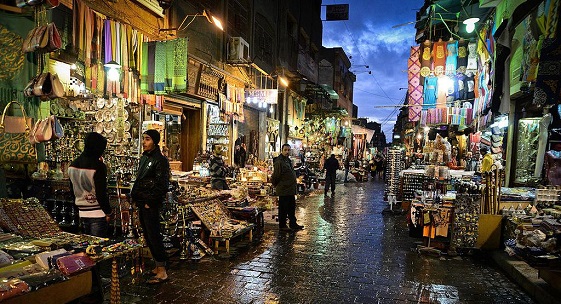
Khan el-Khalili bazaar, one of Cairo's main tourist attractions: Egypt's new program aims to stabilize the economy and help bring tourists back to the country (photo: Mustafa Ozturk/Andalou Agency/Getty)
A Chance for Change: IMF Agreement to Help Bring Egypt's Economy to Its Full Potential
November 11, 2016
- Egyptian economy faces both urgent and long-standing structural challenges
- Program to restore macroeconomic stability, promote growth and employment
- Strengthening social safety nets is an important component
The IMF has approved a three-year, $12 billion loan to support the government’s home-grown comprehensive economic reform plan. The loan will be provided under the Extended Fund Facility and also includes measures to protect the poor.
Long-standing economic challenges
Political instability, regional security issues, and the global economic slowdown have negatively affected the Egyptian economy, amplifying its long-standing structural problems.
-
Fixed exchange rates: Keeping the Egyptian pound exchange rate fixed to the U.S. dollar did not serve the economy well. Egypt’s external competitiveness was undermined, foreign reserves were depleted, and foreign exchange shortages negatively affected investment, leading to a decline in confidence and, occasionally, to food shortages.
-
High government deficit and public debt: Weak revenue combined with poorly targeted subsidies and a growing public sector wage bill resulted in large deficits and high level of public debt, nearing 100 percent of GDP.
-
Low growth: Long-standing structural issues have been constraining growth and employment. Growth has not been inclusive and failed to generate enough jobs, especially for young people and women.
Helping the Egyptian people
As noted by IMF Managing Director Christine Lagarde, "the program is by the Egyptian government, for the Egyptian people, and to help the Egyptian economy.” The new reform program seeks to revive Egypt’s growth prospects by restoring stability and confidence in the economy, and implementing structural reforms that will create jobs.
The key components include:
-
Maintaining a flexible exchange rate regime: This will help to improve Egypt’s external competitiveness, support exports and tourism, and attract foreign investment. This will also allow the Central Bank of Egypt to rebuild its international reserves. Monetary policy will focus on containing inflation and bringing it down to mid-single digits over the medium term.
-
Strengthening government revenues : The value-added tax (VAT), which was adopted in August 2016, will help strengthen budget revenues. To protect the most vulnerable segments of society, the new VAT includes exemptions for most staple foods consumed by the poor.
-
Implementing energy subsidy reforms: The energy subsidies are not well-targeted and benefit mostly the non-poor. They also skew production toward energy-intensive industries and away from labor-intensive and job-creating enterprises. Reforming these schemes would free up resources that can be spent on priority areas such as health, education, research and development, and social protection.
-
Strengthening social protection programs: About 1 percent of GDP from fiscal savings will be directed to additional food subsidies and cash transfers to the elderly and poor families. Resources for social programs such as school meals, subsidies for infant milk and children’s medicine, and vocational training for young people will also be preserved, and in the case of free school meals, greatly increased.
-
Boosting growth through wide-ranging structural reforms: Reforms to improve the business climate—such as streamlining industrial licensing, and facilitating access to finance for small and medium-sized enterprises—are also a key component of this program. These measures will boost job creation and help to address Egypt’s high unemployment, which is particularly acute for young people and women. Making more public nurseries available and improving the safety of public transportation will make it easier for Egyptian women to work outside the home.
An opportunity for a better future
Egypt is a country with immense potential. It has a dynamic and young population, a large market size, a favorable geographic location, and access to important foreign markets.
The opening of the parallel Suez Canal, large investments in the energy sector, and the discovery of a major gas field also bode well for Egypt’s growth potential.
With sound implementation of the program, growth could rebound to 6 percent by 2021—similar to the levels in 2005-2010. “The government’s reform program supported by the IMF aims to raise growth, make it easier for women and young people to find work, and protect the poor and other vulnerable groups,” said IMF Mission Chief for Egypt Chris Jarvis.
Key features of economic reform program
-
A flexible exchange rate regime to remove overvaluation, rebuild reserves, and provide buffers for external shocks;
-
Monetary tightening to contain inflation;
-
Fiscal consolidation to ensure medium-term public debt sustainability;
-
Strengthening social safety nets and increasing pro-poor spending to offset impact of the reforms on the vulnerable; and
-
Structural reforms to promote inclusive growth, create jobs, increase and diversify exports, improve the business environment, and strengthen public finance management.








